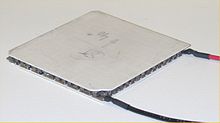- Nernst effect
-
Thermoelectric effect  PrinciplesApplicationsThermoelectric materials · Thermocouple · Thermopile · Thermoelectric cooling · Thermoelectric generator · Radioisotope thermoelectric generator · Automotive thermoelectric generator
PrinciplesApplicationsThermoelectric materials · Thermocouple · Thermopile · Thermoelectric cooling · Thermoelectric generator · Radioisotope thermoelectric generator · Automotive thermoelectric generatorIn physics and chemistry, the Nernst Effect (also termed first Nernst–Ettingshausen effect, after Walther Nernst and Albert von Ettingshausen; note "Ettingshausen" is frequently misspelled "Ettinghausen") is a thermoelectric (or thermomagnetic) phenomenon observed when a sample allowing electrical conduction is subjected to a magnetic field and a temperature gradient normal (perpendicular) to each other. An electric field will be induced normal to both.
This effect is quantified by the Nernst coefficient |N|, which is defined to be
where EY is the y-component of the electric field that results from the magnetic field's z-component BZ and the temperature gradient dT / dx.
The reverse process is known as the Ettingshausen effect and also as the second Nernst-Ettingshausen effect.
Contents
Physical picture
Mobile energy carriers (for example conduction-band electrons in a semiconductor) will move along temperature gradients due to statistics and the relationship between temperature and kinetic energy. If there is a magnetic field transversal to the temperature gradient and the carriers are electrically charged, they experience a force perpendicular to their direction of motion (also the direction of the temperature gradient) and to the magnetic field. Thus, a perpendicular electric field is induced.
Sample types
Semiconductors exhibit the Nernst effect. This has been studied in the 1950s by Krylova, Mochan and many others. In metals however, it is almost non-existent. It appears in the vortex phase of type-II superconductors due to vortex motion. This has been studied by Huebener et al. High-temperature superconductors exhibit the Nernst effect both in the superconducting and in the pseudogap phase, as was first found by Xu et al. Heavy-Fermion superconductors can show a strong Nernst signal which is likely not due to the vortices, as was found by Bel et al.
See also
- Seebeck effect
- Peltier effect
- Hall effect
- Righi–Leduc effect
Journal articles
- R. P. Huebener and A. Seher, "Nernst Effect and Flux Flow in Superconductors. I. Niobium", Web
- R. P. Huebener and A. Seher, "Nernst Effect and Flux Flow in Superconductors. II. Lead Films", Web
- V. A. Rowe and R. P. Huebener, "Nernst Effect and Flux Flow in Superconductors. III. Films of Tin and Indium", Web
- Xu, Z. A.; Ong, N. P.; Wang, Y.; Kakeshita, T.; Uchida, S. (2000). "Vortex-like excitations and the onset of superconducting phase fluctuation in underdoped La2-xSrxCuO4". Nature 406 (6795): 486–488. Bibcode 2000Natur.406..486X. doi:10.1038/35020016.
- Bel, R.; Behnia, K.; Nakajima, Y.; Izawa, K.; Matsuda, Y.; Shishido, H.; Settai, R.; Onuki, Y. (2004). "Giant Nernst Effect in CeCoIn5". Physical Review Letters 92 (21): 217002. arXiv:cond-mat/0311473. Bibcode 2004PhRvL..92u7002B. doi:10.1103/PhysRevLett.92.217002.
- Krylova, T. V.; Mochan, I. V. (1955). J. Tech. Phys. (USSR) 25: 2119.
- Nernst effect on arxiv.org
Categories:- Thermodynamics
- Electrodynamics
-
Wikimedia Foundation. 2010.

